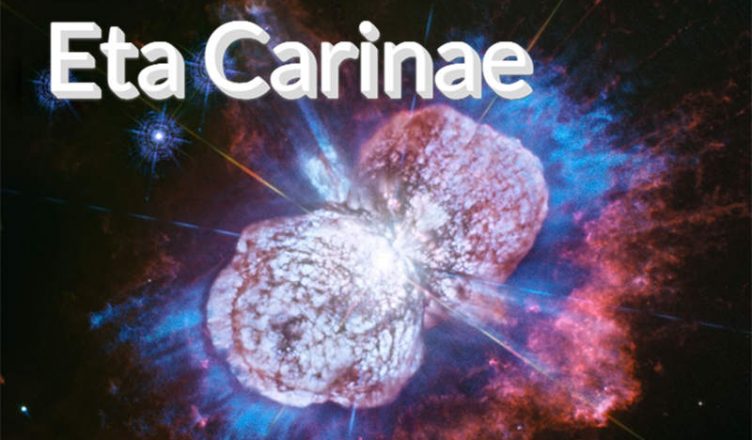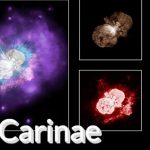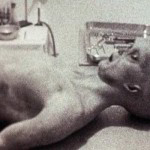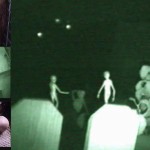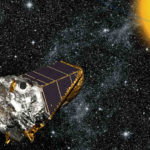In the deep darkness of the cosmos, there exists a star known as ‘Eta Carinae.’ This super-massive star resides at an unreachable distance of 7,500 light-years from us. Today, we will take you on a journey to explore this magnificent celestial entity, a star that has continually brought endless surprises and challenges to astronomers. The latest imagery from the NASA Hubble Space Telescope unveils the enigmatic nature of this largest star in a double-star system, offering a series of unprecedented discoveries. Join us as we embark on this cosmic voyage to unravel the brilliance and mysteries of ‘Eta Carinae.’
Exploring ‘Eta Carinae’: The Spectacular Unveiling of a Cosmic Firework
This super-massive star, known as ‘Eta Carinae’ in the constellation Carina, is the largest star known in a double-star system, residing a staggering 7,500 light-years away from our planet. The Hubble Space Telescope, operated by NASA, has captured a new image, including the invisible ultraviolet spectrum, revealing a breathtaking display of red, white, and blue-hued high-temperature gases resembling the burst of a celestial firework.
The Hubble Space Telescope’s cutting-edge Third-Generation Wide Field Camera has scrutinized the nebula formed by the star’s explosive outburst in ultraviolet light, unveiling embedded magnesium lines, which previous observations had failed to detect. This explosion has given birth to bipolar lobes of dust, gas, and filamentary material. Over two decades, numerous telescopes, including Hubble, have closely monitored this super-massive star, which has always been known for its capricious temperament, prone to sudden outbursts.
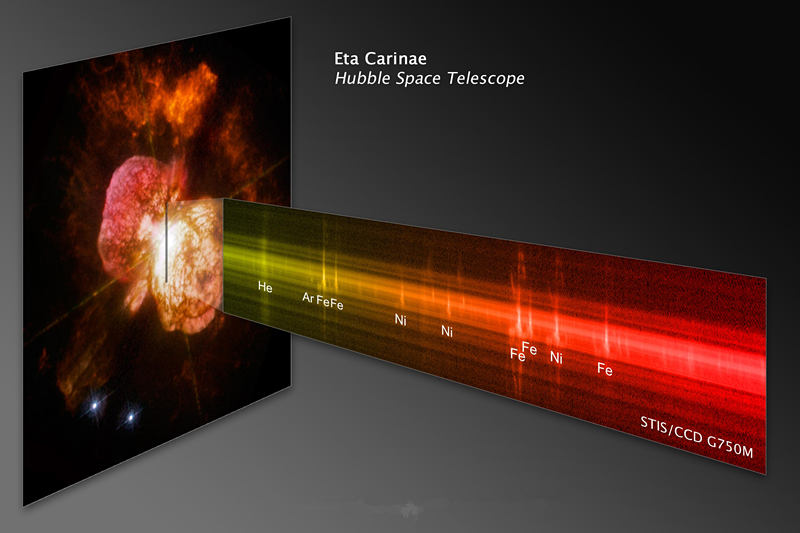
For instance, a significant eruption occurred in the 1840s, during which the explosion ejected gases and dust, forming the distinctive bipolar ‘lobes’ seen in the imagery. Beyond these lobes, external shock heating has enriched the surrounding material with nitrogen, visible as the red regions in the images. In the space between these phenomena, the presence of luminescent magnesium becomes evident, highlighted in the blue portions. Some striking visible features emerge in the blue regions on the lower side of the bipolar lobes, produced by the star’s light scattering off the bubble’s dusty clumps. Wherever ultraviolet radiation penetrates the dense dust, it leaves elongated shadows extending into the surrounding gas.
The star’s outburst has created a pair of dumbbell-shaped bipolar lobes composed of dust, gases, and filamentary materials ejected by Eta Carinae. In its earlier stages, the star’s mass may have exceeded 150 times that of our Sun. For decades, astronomers have speculated that this super-massive star might be on the brink of complete destruction.
This cosmic firework display began in the 1840s when Eta Carinae experienced a highly turbulent ‘Great Eruption,’ making it the second-brightest star for over two decades. In 1844, it reached its peak brightness, second only to Sirius, also known as Alpha Canis Majoris. Despite Sirius being thousands of times closer to Earth than Eta Carinae, the latter was employed as a crucial navigational star by seafarers in the Southern Hemisphere.
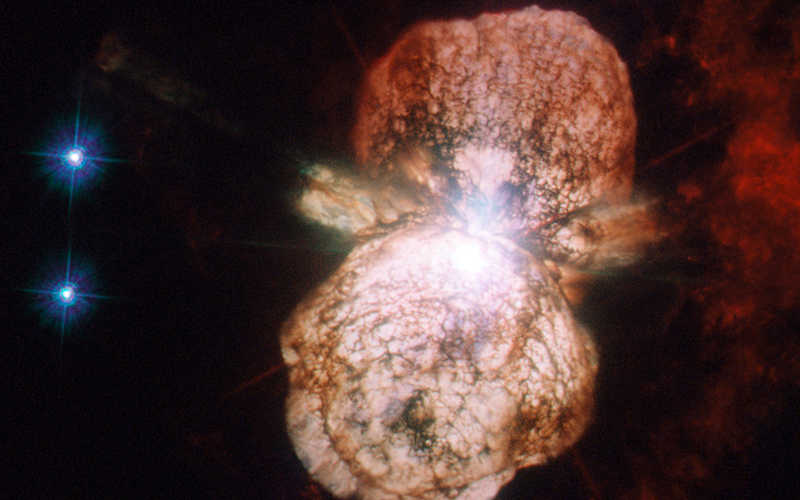
However, since that extraordinary eruption, this star has gradually faded from its former glory, and today, it is nearly invisible to the naked eye. Nevertheless, this grand cosmic firework display is far from over, as Eta Carinae teeters on the brink of annihilation. Over the past 25 years, astronomers have exhaustively utilized the various instruments on the Hubble Space Telescope to study this tumultuous celestial entity.
Revealing Eta Carinae’s Unprecedented Cosmic Secrets: The Spectacular Aftermath of a Great Eruption
In the mid-19th century, sailors navigating the southern seas relied on a brilliant star within the Carina constellation to guide their nocturnal voyages. This star, named Eta Carinae, had been one of the brightest stars in the sky for over a decade. Those sailors of yesteryears would probably find it hard to fathom that by the mid-1860s, this dazzling celestial body had become invisible to the naked eye, shrouded in a dense cloud of dust due to a violent eruption known as the “Great Eruption.”
The Hubble Space Telescope’s third-generation Wide Field Camera 3 (WFC3) captured the ultraviolet light emitted by embedded magnesium within the high-temperature gas, represented as blue in the images. This groundbreaking discovery has left astronomers astounded, as such a phenomenon had never been observed in previous images.
Scientists had long known that following the “Great Eruption” in the 1840s, material ejected from the star’s outer layers had fallen back onto the previously expelled matter and was subsequently heated by shockwaves. The research team had anticipated finding light from magnesium in the newly captured images within the complex, filamentary structures, which had originally been illuminated by nitrogen emissions shown in red. Unexpectedly, a completely novel magnesium emission structure was discovered between the ejected bipolar bubbles and the nitrogen-rich filamentary material created by external shockwave heating.
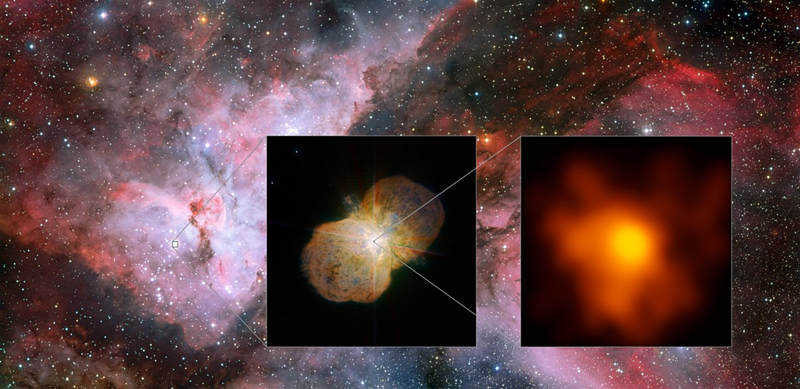
“We found significant amounts of high-temperature gas that has not yet interacted with the surrounding material of Eta Carinae,” explained Nathan Smith, an investigator with the Hubble program, who is affiliated with the Steward Observatory at the University of Arizona in Tucson. “Most of the ejections occurred in places we initially expected to be empty. The unexpected high-velocity ejection of material, given the high total energy of the stellar explosion, further complicates the scenario.”
This newly discovered gas is crucial in understanding the formation of the “Great Eruption” because it represents rapidly expelled, high-energy material, likely ejected from the star just before the formation of the dumbbell-shaped bipolar bubbles. Further observations are necessary to accurately measure the speed and timing of the gas and dust ejections.
On the outer edge of the bipolar bubbles’ lower left lobe, there is a region of blue, where visible light bands are highly noticeable in the images. These bands are formed when the star’s own light pierces through the dust clumps forming the bubble’s surface, resulting in scattered light that creates these bands. Regardless of where ultraviolet light strikes the dense dust, it leaves elongated shadows extending from the dust bubble to the surrounding gas.
Jon Morse, a team member from the BoldlyGo Institute in New York, noted, “This interplay of light and shadows is reminiscent of the sunlight beams seen within the atmosphere when the sun shines on the edge of a cloud, even though Eta Carinae’s physical mechanisms for producing this light are different.”
Researchers emphasize that this technique of detecting high-temperature gases in the ultraviolet range can also be applied to the study of other stars and gaseous nebulae.
Revealing Unseen Gases: Hubble’s New Ultraviolet Images of Eta Carinae
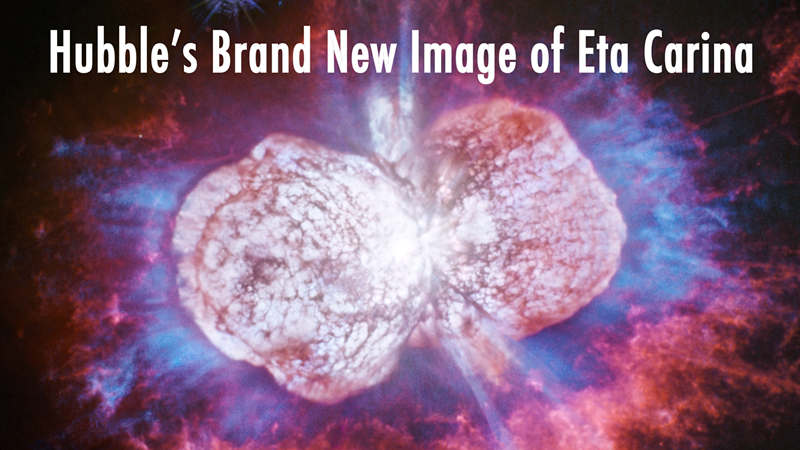
For decades, we have been using the Hubble Space Telescope to study Eta Carinae in visible and infrared light, documenting the turbulent ejections of gases and dust during its eruptive phases. We believed our records to be quite comprehensive. However, the new ultraviolet images taken this time reveal something unexpected: the presence of gases where no material was found in previous visible and infrared images,” said Smith. “Protostars and other dying stars on the brink of destruction can also spew various gases and dust, some of which may have remained undetectable until now, and the discovery of magnesium emissions in ultraviolet light is truly exciting. These images can only be captured by the Hubble Telescope.”
Eta Carinae has a long history of instability, often undergoing dramatic outbursts where it expels portions of its material into space, akin to an interstellar geyser. What causes this monstrous star to exhibit such peculiar behavior? One explanation lies in the gravitational interactions when three stars are bound within a single system. In such a scenario, the largest of the three stars can consume one of the others, triggering a massive outburst, as witnessed during the mid-19th-century Great Eruption.
Ultimately, Eta Carinae is destined for a supernova explosion, concluding its extraordinary cosmic fireworks. The cataclysmic finale may have already occurred, with the dazzling late-stage “light fountain” yet to reach our earthly vantage point.
The Hubble Space Telescope is an international collaboration between NASA and the European Space Agency (ESA), with NASA’s Goddard Space Flight Center in Greenbelt, Maryland, responsible for the telescope’s operations and maintenance. The scientific operation of the telescope is managed by the Space Telescope Science Institute (STScI) in Baltimore, Maryland, on behalf of the Association of Universities for Research in Astronomy (AURA).
END:
While we have delved deep into the splendor of Eta Carinae, this star still holds numerous mysteries and the future remains uncertain. With advancing technologies and the continuous efforts of scientists, we can anticipate gaining a more profound understanding of this peculiar supermassive star. In the future, we can look forward to more exciting discoveries about Eta Carinae, which will aid in unlocking more of the universe’s enigmatic secrets.
The history and future of Eta Carinae are filled with grandeur and mystery, much like the approaching climax of a cosmic fireworks display. The impending supernova explosion of this star will be an awe-inspiring event, and we can anticipate that future astronomers will continue to track and document this magnificent process.
As the Hubble Space Telescope continues to illuminate our path in the cosmos, we will press forward in our exploration of stellar wonders and enigmas. Eta Carinae will persist in inspiring us, kindling our curiosity about the universe, and providing fresh insights to the scientific community. This endless journey through space has only just begun, and we eagerly await future discoveries and adventures.
Let us collectively look forward to more stories about Eta Carinae in the future, as cosmic marvels continue to unfold before our eyes.
More UFOs and mysterious files, please check out our YouTube channel: MysFiles
What NASA found on Mars in 2023? New Evidence of life on Mars?
